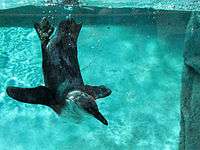Seneca Park Zoo
|
| |
| Date opened | 1894[1] |
|---|---|
| Location | Rochester, New York, United States |
| Coordinates | 43°12′23″N 77°37′26″W / 43.2065°N 77.6238°WCoordinates: 43°12′23″N 77°37′26″W / 43.2065°N 77.6238°W |
| Land area | 15.5 acres (6.3 ha)[2] |
| Annual visitors | 425,550 (2012)[1] |
| Memberships | AZA[3] |
| Website |
senecaparkzoo |
Seneca Park Zoo is a 15.5-acre (6.3 ha) zoo located in Rochester, New York. The zoo is home to over 90 species including mammals, reptiles, birds, amphibians, fish, and arachnids. It is accredited by the Association of Zoos and Aquariums (AZA). The zoo is operated by Monroe County with support from the Seneca Park Zoo Society. The current zoo director is Larry Sorel. The executive director of the Seneca Park Zoo Society is Pamela Reed Sanchez. The zoo opened in 1894 in Seneca Park.
History
Seneca Park, designed by Frederick Law Olmsted, is located on the border of the City of Rochester and the Town of Irondequoit, along the Genesee River. The park was opened in 1893, and animals started being displayed in 1894. The first major addition to the zoo was the Main Zoo Building in 1931. The building was home to a wide variety of animals in cages.[1]
The Seneca Park Zoo Society was chartered as an educational institution by New York State in 1957. Since that time, the Society has evolved into a non-profit organization that supports and promotes the zoo by running educational programs, special events, marketing and public relations efforts, fundraising and food and gift operations. The Society offers memberships that are very popular with area families.[1]
In 1975, a polar bear grotto was opened to house the zoo's two polar bears (Penny and Nickels), who had been acquired using pennies and nickels collected by local school children. In 1993, the zoo opened the $2 million Genesee Trail and Discovery Center—its first landscape immersion exhibit. This was followed in 1997 by the $8.2 million Rocky Coasts exhibit[1]
On May 17, 2012, the zoo opened A Step Into Africa, which was designed to replicate a portion of the NgoroNgoro Crater in Tanzania. This section of the zoo houses African elephants, olive baboons, African lions and domestic goats.[4]
Exhibits
The Rocky Coasts exhibit opened in 1997. It is an area dedicated to animals of the polar and temperate coastal regions of the world, including African penguins, California sea lions, polar bears, snowy owls, Canada lynx, and sandhill cranes. The exhibit includes an underwater viewing area which places visitors close to the sea lions and polar bears swimming behind large glass windows.

A Step Into Africa was unveiled in 2012 and the exhibit includes a replica Maasai hut, Dig Zone for uncovering casts of fossils, interactive learning tools, and a stationary safari bus from which the zoo's African lions can be viewed. The area is home to the zoo's African elephants, olive baboons, and African lions, in naturalistic settings. Seneca Park Zoo is home to the only four African elephants in New York State.[5][6]
The zoo's animal collection changes periodically with AZA recommendations regarding breeding through the Species Survival Plans (SSPs), animal deaths and births. The spring of 2013 proved to be a very fruitful time at the zoo as it welcomed two African lion cubs, six African penguin chicks, one golden lion tamarin baby, three domestic goat kids, a California sea lion pup and a Bornean orangutan baby.
Education and conservation
Seneca Park Zoo reaches out to many communities in the Western New York region to educate the public with regards to animal and resource conservation, environmental awareness and recycling programs. The zoo is a popular destination for school field trips and the zoo has created expeditions for schoolchildren to learn specific lessons in a zoo setting. The ZooMobile, sponsored by Wegmans, brings small, transportable animals to places like recreation centers, libraries, festivals, senior living facilities and schools. The Butterfly Beltway program, sponsored by the Daisy Marquis Jones Foundation,is a program aimed at planting butterfly gardens to increase populations of monarch butterflies, vital pollinators in the region. Additional programs such as summer programming, ZooCamp and ZooTeens give the community an opportunity to enjoy first-hand experiences with educators, zoo keepers and animals.

Events
Seneca Park Zoo hosts many events throughout the year including free-with-admission events such as animal birthdays and conservation and species awareness days. Popular fundraisers include ZooBrew (The Wildest Happy Hour in Town), Zoobilation (annual gala), ZooBoo (Halloween), and Breakfast with Santa. The Jungle Jog 5K race that occurs in July of each year boasts a course that takes runners through Seneca Park and the zoo. This 5K is extremely popular with area runners.
References
- 1 2 3 4 5 "Seneca Park Zoo". monroecounty.gov. Monroe County Government. Retrieved May 15, 2012.
- ↑ "Map of the Zoo". senecaparkzoo.org. Seneca Park Zoo. Retrieved May 15, 2012.
- ↑ "List of Accredited Zoos and Aquariums". aza.org. AZA. Retrieved August 4, 2011.
- ↑ "Additional parking for weekend visitors at Seneca Park Zoo". irondequoit.whec.com. Retrieved May 15, 2012.
- ↑ Olson, Deborah. "North American Region Studbook for the African Elephant, 2006 Edition" (PDF). elephanttag.org. International Elephant Foundation. Retrieved May 15, 2012.
- ↑ Olson, Deborah. "North American Region Studbook for the African Elephant, 2011 Edition" (PDF). elephanttag.org. International Elephant Foundation. Retrieved May 15, 2012.